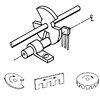I feel like I'm really over thinking this. I want to measure the speed of a shaft at low RPMS down to zero to detect when it first turns. I think a hall effect sensor system is a good candidate. If I mount the magnets on the shaft I will be able to detect a change in voltage indicating the shaft is moving. However, I feel like I can't see a solution right in front of me. I can't figure out how to measure the actual RPM. I can't directly measure the slope because it's a sine wave and the slope is always changing. I'm attempting to code this into an Arduino and I'm struggling to understand what I actually need to calculate to get to RPM.
-
Categories
-
Platforms
-
Content

